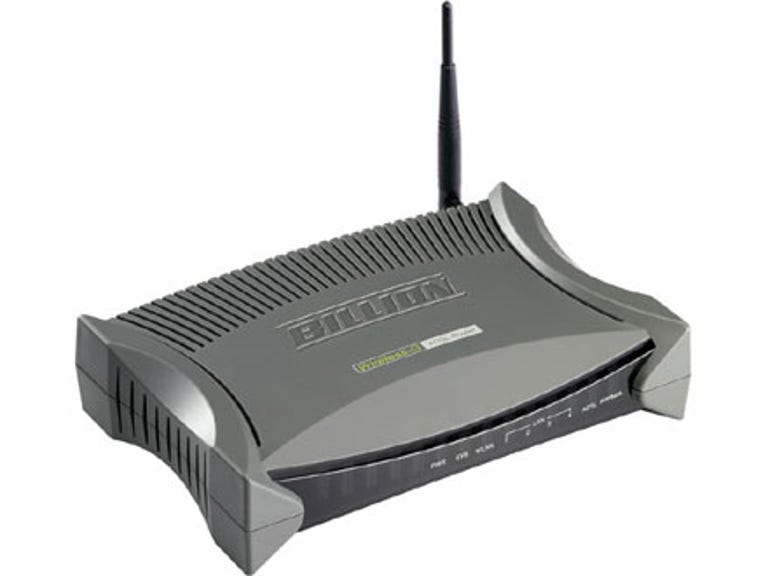 Why You Can Trust CNET
Why You Can Trust CNET Billion BiPAC 7402G review: Billion BiPAC 7402G
An 802.11g wireless router with an integrated ADSL modem suitable for multiple PC homes and small offices.
Thankfully, the Billion 7402G doesn't suffer from the myriad of problems that plagued the NB5580W, such as wireless DHCP dropouts and unstability.
The Good
The Bad
The Bottom Line
And unlike the Belkin Wireless ADSL Router, which had overheating problems, the 7402G has been designed with multiple ventilation slots on the top, sides, base and back to aid airflow.
The 7402G is a grey rectangular box measuring 180 x 120 x 40mm, with hourglass-like curved sides to compensate for its otherwise ordinary look. Four rubber feet raise the router around 1cm off the table. Alternatively, the router can be wall-mounted via two hooks on its base.
A 13cm detachable antenna protrudes from the back of the 7402G. It can be rotated 360o and set parallel, perpendicular or 45o to the base of the router. On the front are eight LEDs to signify power, line sync, WLAN/LAN activity and one that alerts the user to e-mail.
Features
Convergence is the main feature of the 7402G as it eliminates the need for a separate modem, router and wireless access point.
From a technical perspective, the 7402G is in fact is an integrated ADSL2/2+ modem (backwards compatible with the original ADSL standard), a 4-port Ethernet switch and a 802.11b/g wireless access point. Its features also include single session VPN passthrough, an SPI firewall, DoS protection and URL filtering -- pretty much everything a home or small office needs to securely and efficiently share a Net connection with multiple PCs.
Similar to Billion's myGuard 7500GL, the 7402's supports a quality of service (QoS) prioritisation feature that allows home users -- or small business network administrators -- to control network traffic on the LAN by giving priority to certain PCs and applications.
For example, in your home you may wish to devote 30% of the bandwidth to online gaming, 25% to Skype VoIP calls, 20% each for e-mail and file transfers, and only 5% for peer-to-peer file sharing applications, when the network load is high. Setting this up is not exactly a walk in the park as it requires some level of knowlege on networking concepts such as IP addresses, protocols and port numbers.
By configuring inbound and outbound IP throttling, you can also place bandwidth limitations on different PCs. For instance, on a 1.5Mbps connection, you might want to place a download limit of 128kbps on the kids' computer, giving the office PC the rest of the bandwidth available.
All of these features are accessible through the router's Web-based configuration tool, which you can test drive here.
What you get in the sales package is the router itself, a power supply, an Ethernet cable, an ADSL line filter and a software CD containing a PDF user manual.
Performance
Initially, we weren't that impressed with the 7402G's modem abilities -- specifically it didn't live up to its claim of supporting ADSL2/2+. When Australian ISPs such as iiNet and Internode started offering ADSL2 and ADSL2+ services, many modem manufacturers were quick to tout their products as compatible. However, the fine print next to these claims stated that they would only be ADSL2/2+ capable with a future firmware upgrade. In the case of the Billion 7402G, the packaging stated the modem was "optional with ADSL2+". We feel this isn't being entirely honest with consumers as early adopters were stuck waiting for months for the firmware upgrade to be made available.
Nevertheless, after working alongside ISPs to iron out the bugs, working firmware was released and is now available for download from Billion's Web site.
Aside from the aforementioned problems with waiting for a firmware upgrade, the 7402G performed admirably as both a modem and a router. It was a stable router throughout our test period, maintaining line sync and rarely dropping wireless clients.
After downloading the latest firmware patch from the support section of Billion's Web site, we were able to sync at 12Mbps / 1Mbps to an ADSL2 account without any drop-outs. We found the 7402G took about one and a half minutes to achieve line synchronisation.
Billion offers telephone and e-mail support to its customers. The 741ge.com community forum is also an excellent resource for FAQs, setup guides and technical issues.
Update (1 August, 2005): PC Range, the Australian distributor of Billion products, told CNET.com.au that the 7402G is now shipping with support for ADSL2+ out of the box.



